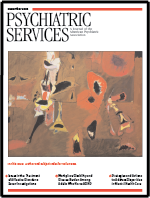Past and Current Views on the Use of Seclusion and Restraint in Treatment
To the Editor: The September issue of Psychiatric Services presents encouraging news that agitated patients are being successfully treated without the use of restraint or seclusion.
The question of restraint has a long history of disagreement among physicians in mental hospitals. At its first meeting in 1844, the newly organized Association of Medical Superintendents of American Institutions for the Insane (now the American Psychiatric Association) passed its first proposition: "It is the unanimous sense of this convention that the attempt to abandon entirely the use of all means of personal restraint is not sanctioned by the true interests of the insane." This consensus was debated throughout the 19th century—but in the end it was always supported (1).
Nineteenth-century British psychiatrists were opposed to mechanical restraint, although "holding" by attendants was allowed. The Quakers who opened the York Retreat in 1796 opposed the use of restraint. Dr. John Conolly, who was superintendent of the Middlesex County Asylum in Hanwell, published a book in 1856 titled Treatment of the Insane Without Mechanical Restraint (2). In 1875, when Dr. John Bucknill, a former superintendent of a British asylum, visited American asylums, he found that the private ones used little or no restraint but the public mental hospitals used restraint often. He wrote in a Lancet article in 1876 that "[the superintendents] will look back to their defense [of restraint] with the same wonderment … that has been said in defense of domestic slavery" (3).
Perhaps the articles in Psychiatric Services reflect a new era in the treatment of mental patients in hospitals.
Dr. Ozarin was formerly medical director of the U.S. Public Health Service.
1. Barton W: The History and Influence of the American Psychiatric Association. Washington DC, American Psychiatric Press, 1987Google Scholar
2. Conolly J: Treatment of the Insane Without Mechanical Restraint. London, Smith, Elder, 1856Google Scholar
3. Bucknill J: Notes on Asylums for the Insane in America. London: Churchill, 1876Google Scholar



